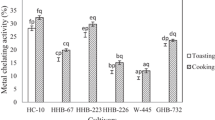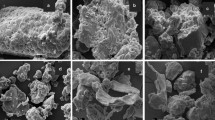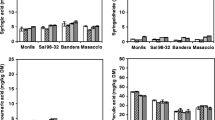Abstract
Processing methods involved in value addition to pigmented broken rice, a milling by-product may affect the nutraceutical qualities. Hence the effect of pulverisation and toasting on nutraceutical content in brown rice flours of red and black rice varieties were studied. Plate milling reduced soluble, bound and total polyphenols in red, but increased in black; increased insoluble polyphenols and oryzanol, and reduced anthocyanin in both varieties; antioxidant activity is reduced in red, but increased in black. Toasting caused reduction of soluble, insoluble and total polyphenol, anthocyanin and antioxidant activity in both varieties with an increase in bound polyphenols, and retention of flavonoids and oryzanol. HPLC characterization of phenolics showed changes on processing in content of catechin, caffeic, vanillic, protocatechuic and ferulic acid. It can be concluded that processing impacts the phenolic components of pigmented broken brown rice flour and this information is useful for functional food industry.
Similar content being viewed by others
References
Abdel-Aal ESM, Rabalski I (2013) Effect of baking on free and bound phenolic acids in whole grain bakery products. J Cereal Sci 57:312–318
Alu’datt MH, Rababah T, Ereifej K, Alli I (2013) Distribution, antioxidant and characterization of phenolic compounds in soybeans, flaxseed, and olives. Food Chem 139:93–99
Bao JS, Cai Y, Sun M, Wang GY, Corke H (2005) Anthocyanins, flavonols, and free radical scavenging activity of Chinese bayberry (Myrica rubra) extracts and their color properties and stability. J Agric Food Chem 53:2327–2332
Bondet V, Brand-Williams W, Berset C (1997) Kinetics and mechanisms of antioxidant activity using the DPPH-free radical method. LWT Food Sci Technol 30:609–615
Deng GF, Xu XR, Zhang Y, Li D, Gan RY, Li HB (2013) Phenolic compounds and bioactivities of pigmented rice. Crit Rev Food Sci Nutr 53:296–306
Earp CF, Akingbala JO, Ring SH, Rooney LW (1981) Evaluation of several methods to determine tannins in sorghums with varying kernel characteristics. Cereal Chem 58:234–238
Embaby HES (2010) Effect of soaking, dehulling, and cooking methods on certain anti-nutrients and in vitro protein digestibility of bitter and sweet lupin seeds. Food Sci Biotechnol 19:1055–1062
Finocchiaro F, Ferrari B, Gianinetti A, Dall’asta C, Galaverna G, Scazzina F, Pellegrini N (2007) Characterization of antioxidant compounds of red and white rice and changes in total antioxidant capacity during processing. Mol Nutr Food Res 51:1006–1019
Giusti MM, Wrolstad RE (2001) Characterization and measurement of anthocyanins by UV–Visible spectroscopy. Curr Protoc Food Anal Chem. https://doi.org/10.1002/0471142913.faf0102s00
Goufo P, Trindade H (2014) Rice antioxidants: phenolic acids, flavonoids, anthocyanins, proanthocyanidins, tocopherols, tocotrienols, c-oryzanol, and phytic acid. Food Sci Nutr 2(2):75–104
Haridas Rao P, Leelavathi K, Shurpalekar SR (1989) Effect of damaged starch on the chapati-making quality of whole wheat flour. Cereal Chem 66(4):329–333
Hiemori M, Koh E, Mitchell AE (2009) Influence of cooking on anthocyanins in black rice (Oryza sativa L. japonicavar. SBR). J Agric Food Chem 57:1908–1914
Kaur P, Singh N, Pal P, Kaur A (2018) Variation in composition, protein and pasting characteristics of different pigmented and non-pigmented rice (Oryza sativa L.) grown in Indian Himalayan region. J Food Sci Technol 55(9):3809–3820
Khatoon S, Gopalakrishna AG (2004) Fat-soluble nutraceuticals and fatty acid composition of selected Indian rice varieties. J Am Oil Chem Soc 81:939–943
Ktenioudaki A, Alverez-Jubate L, Gallagher E (2014) A review of the process-induced changes in the phytochemical content of cereal grains: the bread making process. Crit Rev Food Sci Nutr 55:611–619
Marinova EM, Yanishlieva NV (1992) Effect of temperature on the antioxidative action of inhibitors in lipid autoxidation. J Sci Food Agric 60:313–318
Monks JLF, Vanier NL, Casaril J, Berto RM, de Oliveira M, Gomes CB, de Carvalho MP, Dias ARG, Elias MC (2013) Effects of milling on proximate composition, folic acid, fatty acids and technological properties of rice. J Food Compost Anal 30:73–79
Moore J, Luther M, Cheng Z, Yu LL (2009) Effects of baking conditions, dough fermentation, and bran particle size on antioxidant properties of whole-wheat pizza crusts. J Agric Food Chem 57:832–839
Nithya KS, Ramachandramurty B, Krishnamoorthy VV (2007) Effect of processing methods on nutritional and anti-nutritional qualities of hybrid (COHCU-8) and traditional (CO7) pearl millet varieties of India. J Biol Sci 7:643–647
Pascual CDCI, Massaretto IL, Kawassaki F, Barros RMC, Noldin JA, Marquez UML (2013) Effects of parboiling, storage and cooking on the levels of tocopherols, tocotrienols, and γ-Oryzanol in brown rice (Oryza sativa L.). Food Res Int 50:676–681
Pradeep PM, Jayadeep A, Guha M, Singh V (2014) Hydrothermal and biotechnological treatments on nutraceutical content and antioxidant activity of rice bran. J Cereal Sci 60:187–192
Queiroz YS, Manolio SRA, Capriles VDC, Toress EA, Areas JA (2009) Effect of processing on the antioxidant activity of amaranth grain. Arch Latinoam Nutr 59:419–424
Rehman ZU, Shah WH (2005) Thermal heat processing effects on anti-nutrients, protein and starch digestibility of food legumes. Food Chem 91(2):327–331
Seetharamaiah GS, Prabhakar JV (1986) Oryzan ol content of Indian rice bran oil and its extraction from soap stock. J Food Sci Technol 23:270–274
Singleton VL, Orthofer R, Lamuela-Raventos RM (1999) Analysis of total phenols and other oxidation substrates and antioxidants by means of Folin–Ciocalteu reagent. Methods Enzymol 299:152–178
Smitha VK, Kumar Sourav, Malleshi NG (2008) Studies on the effect of milling finger millet in different pulverisers on physico-chemical properties of the flour. J Food Sci Technol 45(5):398–405
Tian S, Nakamura K, Kayahara H (2004) Analysis of phenolic compounds in white rice, brown rice, and germinated brown rice. J Agric Food Chem 52:4808–4813
Walter M, Marchesan E, Massoni PFS, Silva LP, Sartori GMS, Ferreira RB (2013) Antioxidant properties of rice grains with light brown, red and black pericarp colors and the effect of processing. Food Res Int 50:698–703
Wanyo P, Kaewseejan N, Meeso N, Siriamornpun S (2016) Bioactive compounds and antioxidant properties of different solvent extracts derived from Thai rice by-products. Appl Biol Chem 59:373–384
Xu G, Ye X, Chen J, Liu D (2007) Effect of heat treatment on the phenolic compounds and antioxidant capacity of citrus peel extract. J Agric Food Chem 55:330–335
Acknowledgements
Project funded by Govt. of India XII plan Project AGROPATHY (BSC0105).
Author information
Authors and Affiliations
Corresponding author
Ethics declarations
Conflict of interest
The authors declare that there is no conflict of interest.
Electronic supplementary material
Below is the link to the electronic supplementary material.
Rights and permissions
About this article
Cite this article
Sapna, I., Kamaljit, M., Priya, R. et al. Milling and thermal treatment induced changes on phenolic components and antioxidant activities of pigmented rice flours. J Food Sci Technol 56, 273–280 (2019). https://doi.org/10.1007/s13197-018-3487-1
Revised:
Accepted:
Published:
Issue Date:
DOI: https://doi.org/10.1007/s13197-018-3487-1




